rslifkin
Guru
- Joined
- Aug 20, 2019
- Messages
- 7,584
- Location
- USA
- Vessel Name
- Hour Glass
- Vessel Make
- Chris Craft 381 Catalina
I'd like to do a strain gauge test on my boat, but my gut feel from feeling rode tension is that idle reverse for me on both engines is similar to somewhere around 20-25 kts of wind. That means my usual 1000 rpm test is good for more, probably more like 30 - 40 kts equivalent.
I've anchored for short periods with a little over 70 feet out in 19 feet of water (plus just under 6 feet roller height), so just under 3:1 scope. It held idle reverse no problem with 10 kts blowing at the time. Didn't throttle up beyond idle though. At 3.5:1 in 48 feet of water it'll hold 1000 rpm plus 20 kts with no trouble at all. In that second case, it was rather hard to break out and mud marks indicate the anchor was fully buried (including the whole shank) in the sticky, gooey mud it brought up.
The low settting rpm with a pair of 22 inch props is probably comparable to the force a similar size average sailboat would generate with nearly full throttle.
I've anchored for short periods with a little over 70 feet out in 19 feet of water (plus just under 6 feet roller height), so just under 3:1 scope. It held idle reverse no problem with 10 kts blowing at the time. Didn't throttle up beyond idle though. At 3.5:1 in 48 feet of water it'll hold 1000 rpm plus 20 kts with no trouble at all. In that second case, it was rather hard to break out and mud marks indicate the anchor was fully buried (including the whole shank) in the sticky, gooey mud it brought up.
The low settting rpm with a pair of 22 inch props is probably comparable to the force a similar size average sailboat would generate with nearly full throttle.
Last edited:


